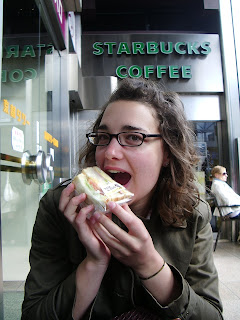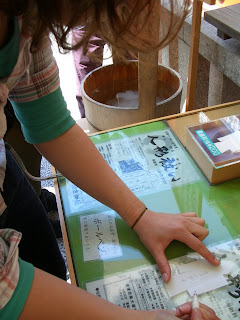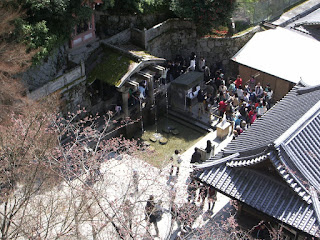This post is very long. When I realized how long it was going to be, I thought maybe I could break it up, but since the draft had been saved for a while, and I have posted since, it would have been all out of order. ごめん。
Day 2
With many places to visit on our itinerary, we started early-ish and grabbed breakfast at a café on a corner with many other tourists. Places that serve breakfast in Japan are few and far between, limited mostly to fancy hotels and coffee shops. After indulging in some waffles, we hopped on the bus to Nijo Castle. During my last visit to Kyoto in January, the castle was closed in observance of the New Year, so I was very eager to see it.

Nijo from the outside...
 ...and looking down from the inside.
...and looking down from the inside.Nijo-castle isn’t really a castle in the traditional sense—it isn’t a multistoried fortress, but rather a residence of the Imperial family. The main building is impressively large though, especially considering it was built in the 1600’s. The most notable feature of the castle is its “nightingale floors,” a security feature installed by a paranoid shogun to alert him to the presence of ninja attackers. The squeaky floors still work, and during one’s tour of the castle, it sounds like there are many peeping birds under the building. The main building also houses impressive screen paintings in each room, which are now starting to be restored. All the screens around the exterior of the castle are closed now to protect the screen paintings, keeping the castle in the dark, but with all the gold leaf, the screens must have been quite impressive in their day. The main “castle” building is surrounded by a moat and nice Japanese style gardens, which we took in before hoping on another bus to our next destination.
Stop 2 was Kinkakuji, which was just as crowded, if not more so than the last time I was there. It is quite impressive to see the glowing, gold pavilion on the lake, but it would also be much nicer with fewer people. We did a brief tour along the garden path (mostly because you have to in order to find the exit) and stopped for a snack before heading back to the bus stop.

 Snack Time!!! ソフトークリム for me, and chocolate covered mochi, or だんご for Kim-chan.
Snack Time!!! ソフトークリム for me, and chocolate covered mochi, or だんご for Kim-chan.The next place we intended to visit was Toji Temple, the highest pagoda in all of Japan. We eventually got there, taking the long way around on the loop bus (whoops!) Like so many old structures built of wood in Kyoto, Toji Temple has been reconstructed several times due to fire. Toji differs in that four of these fires were caused when the pagoda was struck by lightening. How smart do you have to be to build the tallest structure for miles around out of wood? Over and over and over and over again? I trust that now they have taken special precautions (i.e. a lightening rod) to prevent it from happening again. Toji is quite impressive, and is a symbol of Kyoto. The actual site is made even more lovely due to the fact that it is in a rather shabby, industrial looking part of the city.


After doing our tour, we got on the last bus of the day and headed east towards Tofuku-ji. Like the hostel, it proved a tad difficult to locate. Just when we had gone under the big gate, we were kindly asked to leave because they were closing. Rather disappointed, we asked how long the walk was to our last stop of the day, Fushimi Inari and set out.
Fushimi Inari is a shrine located on the south eastern edge of Kyoto city. It is dedicated to the fox, considered to be the messenger of the gods. Fushimi Inari is best known for its miles and miles of red torii gates of all sizes, lined up through the forest. It would have taken hours to hike through all of them, and Kim, Karl and I agreed that our 40 minute foray among them in the dwindling daylight was sufficient. Back to Kyoto proper for dinner and an early night.
Front entrance of Fushimi Inari. Can you see the fox statutes standing guard on either side of the gate?

Day 3
Another full agenda for Kim and me; the first item was to check out of the hostel and accompany Karl to the station to see him off and put our bags in a locker for the day. That accomplished, we got some nourishment at Starbucks, and got on a bus headed towards the eastern side of Kyoto.
Another full agenda for Kim and me; the first item was to check out of the hostel and accompany Karl to the station to see him off and put our bags in a locker for the day. That accomplished, we got some nourishment at Starbucks, and got on a bus headed towards the eastern side of Kyoto.
 The four-bite sandwich I ate for breakfast.
The four-bite sandwich I ate for breakfast.The first official stop was Sanjusangendo Temple. The name refers to the 33 columns that hold up the roof of a very loooooooong building which houses 1,000 statues in the image of Buddha. This was another stop my family didn’t get to during our trip—we arrived just minutes after the last entry of the day, which is why Kim and I thought we should hit it first. In addition to the seemingly never-ending collection of statues, highlights at Sanjusangendo include mentally trying to recreate the annual archery competition held there, and omikuji (paper fortunes)written in English. We deposited our 100 yen into the box and chose a folded up strip of paper from the bin. We both drew “good” fortunes, which we decided to keep instead of tying them to the strings and leaving behind at the temple. A good start to the day.
 The loooooooong building. Unfortunately, no photos of the statues inside. :-(
The loooooooong building. Unfortunately, no photos of the statues inside. :-(From Sanjusangendo, we walked up the hill to Kyomizudera. While it was impressive when I saw it with my family, bright sunshine and the first cherry blossoms of the season made it more lovely the second time. It was also just as crowded, but not so crowded as to discourage Kim and me from waiting in line to drink some of the “holy water” thought to fulfill wishes. We also disposed of our “relationship challenges” by writing them on a special piece of paper and watching them dissolve in a bucket of water. So interactive!!

Kyomizudera's pagoda building through some budding sakura trees.

The station where Kim and I watched our troubles disappear!

Getting them out on paper.
 Watching them disolve. Quite therapeutic actually.
Watching them disolve. Quite therapeutic actually.
Waterfall where we sipped magic water.
From Kyomizudera, it was more walking, this time in a northerly direction to get to Heian Shrine. The entrance to Heian Shrine is the largest red torii gate I have ever seen…it spans four lanes of traffic and is visible from very far away. The shrine itself differs from the many others I have seen and confuse in my mind because it was built in a very Chinese style, with a huge, bare gravel expanse in front. Behind the shrine is an extensive and beautiful Japanese garden, which took a good half an hour to meander through.

Big gate. We must be getting close.

There it is! Heian Shrine.
 A picturesque sakura tree in the garden.
A picturesque sakura tree in the garden.Heian was our last major stop of the day. We started the trek back to Kyoto Station by way of Gion, the geisha district. Gion was a bit like Hollywood, very romanticized, yet when you get there it’s full of ugly tourists. As we walked down the main street, groups of people with cameras were just standing around on the corners, looking as though they were waiting for something to happen. We did happen upon a very pretty street near Gion which had cherry trees starting to bloom on one side and willows on the other…pink and green together. Along another quieter street, we did get to see a geisha on her way to work, which was pretty exciting, but also had the effect of turning us in to paparazzi-ish stalkers.

 With the sun setting on our time in Kyoto, Kim and I returned to the station, got our bags from the locker and after spending about 20 minutes walking around in circles in the underground shopping area, found some suitable souvenirs and some dinner. We got on the train, relieved to be off our feet. Yes, I am getting old.
With the sun setting on our time in Kyoto, Kim and I returned to the station, got our bags from the locker and after spending about 20 minutes walking around in circles in the underground shopping area, found some suitable souvenirs and some dinner. We got on the train, relieved to be off our feet. Yes, I am getting old.


No comments:
Post a Comment